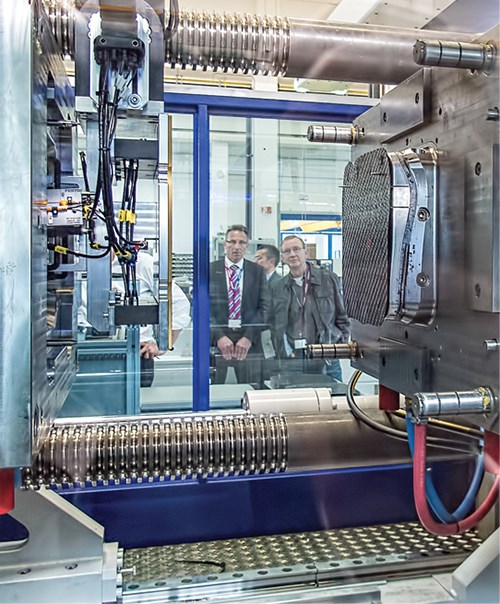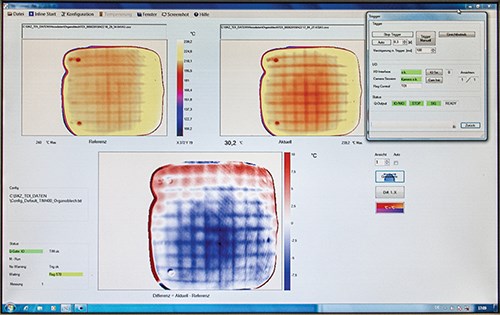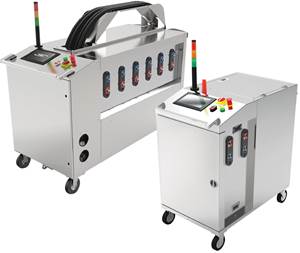Wittmann Battenfeld Previews New Tech For Composites & Cell Integration
Open house in Austria offered a vision of a future with controls linking injection machines to a wide range of auxiliaries. Wittmann also signaled its debut in composite organosheet overmolding—with an added twist.
At its recent MacroPower Days open house in Kottingbrunn, Austria, Wittmann Battenfeld hosted an overflow crowd of 500 visitors for two days of technical presentations, machine demonstrations, and tours of three facilities in Austria and Hungary. In a program focused on large machines, the company outlined its capacity expansion plans and gave a first public look at its entry into the burgeoning field of composite “organosheet” overmolding. However, the most prominent theme of the open house was progress in integrating injection machines with a host of auxiliaries and even with central plant MES or ERP computers—a goal often referred to as “Industry 4.0.”
DON’T WAIT—INTEGRATE!
In the U.S., it is sometimes called the “industrial Internet” or the “Internet of things.” To enthusiasts, Industry 4.0 is “the fourth industrial revolution”—after mechanization in the 18th century, mass production in the 19th century, and automation/computerization in the 20th century, comes networking/intelligence in the 21st century.
To more sober observers, we’re not exactly there yet. In a speech at MacroPower Days, Johannes Rella, Wittmann’s head of software engineering, said implementation is currently limited by low data throughput and a lack of generally accepted standards for cables, interfaces, and protocols. While development and promulgation of such standards will take some time, Wittmann asks the question, “Why wait?”
In the unique position of manufacturing injection machines as well as a wide range of auxiliaries, Wittmann has pushed ahead on its own with the release of its connectivity program called “Wittmann 4.0” at NPE2015 in Orlando. This is a standardized Ethernet communication protocol between all Wittmann machines, robots, and peripherals from a central hub—the Unilog B6P controller of the injection press. This allows visualization of the control screens for robots and auxiliaries on the machine display. Therefore, teach programs for the robots, as well as settings for Tempro TCUs, Gravimax blenders, Flowcon water-flow controllers, etc., will now be stored as part of the complete mold or workcell setup on the molding machine’s controller. Each time a mold is changed, settings for the entire cell are downloaded automatically to all the peripherals, reducing chances for error and saving time. It is now even possible to control the injection machine from the robot control pendant.
In this approach, each injection machine constitutes its own I.P. subnet with up to 16 connected devices, including up 12 TCUs. This hot-swappable, plug-and-play configuration boasts numerous advantages. It is said to run fast, thanks to use of native code. It offers automatic device recognition and auto configuration of the connection, as well as automatic software synchronization.
In Wittmann’s implementation, the peripheral device provides an interface for direct data access; all calculations with respect to screen presentation are handled by an app that can run on the peripheral as well as on the the injection machine controller. This eliminates any issues regarding which software versions are running on the various peripherals. Each peripheral’s software is always sunchronized to the molding machine and runs there in its particular version. Unlike in the past, the injection machine control presents the peripheral screen interfaces just as they would appear on the auxiliary units, not in the format of the injection machine’s interface. Thus, plant personnel visualize the peripherals in the same way as when working with them independently.
Wittmann 4.0 is a work in progress—it currently links Wittmann Battenfeld injection machines to Wittmann robots, blenders, TCUs, and water-flow controllers, though more will follow in the future. In Europe, Wittmann also offers integration of the molding cell with central plant MES or ERP computers through collaboration with T.I.G. GmbH in Austria, an MES software vendor. (For another machine builder’s implementation of Industry 4.0, see Starting Up.)
Another element of Wittmann 4.0 is new WiBa QuickLook, a free mobile app available from the Apple iOS App Store and from Google Play for Android phones. It allows users to check the status of injection machines with Unilog B6 controls and robots with R8 controls from a smartphone or tablet, showing production data and equipment condition, such as alarms. To keep things simple, the app provides only the most important current parameter (or robot program) settings in a production cell. For more detailed information, users must go directly to the machine or robot.
Machine or robot status is color coded green, yellow, or red. Anything in red, indicating a problem, goes to the top of the list on the screen. For security, QuickLook can monitor, but cannot change, machine settings. Also, it is intended for use only within the plant via LAN/WLAN. However, equipment settings viewed on QuickLook can be forwarded to others via email.
TECHNOLOGY DEMOS
Apart from nine technical presentations, the open house presented 10 machine demonstrations, seven of them involving the MacroPower two-platen line. All machines were all-electric or servo-hydraulic powered for energy efficiency and several showed off the versatility of Cartesian robots with five or six axes.
• COMPOSITES: This event was the first public unveiling of Wittmann Battenfeld’s entry into lightweight, high-strength thermoplastic composites. As reported in last month’s Starting Up column, the cell utilized a MacroPower E 450 (450 metric tons), a relatively new hybrid press with servo-electric injection unit. In this cell, a new-model Wittmann W843 pro robot (five-axis with servo wrist) picked up precut blanks of PP organosheet reinforced with continuous-glass fabric, placed them in a drawer-type preheating oven, and then hung the heated sheets on two pins in a mold, where the sheets were formed and overmolded with additional PP. The net-shape (no post-trimming), automotive-type demo parts were made with Tepex sheet from the Bond-Laminates unit of Lanxess (U.S. office in Pittsburgh).
An additional feature, not previously revealed, was an infrared camera that “read” the thermal profile of the sheet after the robot removed it from the oven drawer and displayed that profile on a screen beside the press. The online thermography system was developed by the South German Plastics Center, or SKZ Würzburg, which has collaborated with Wittmann Battenfeld at various shows since K 2010 (see Jan. ’11).
• SANDWICH MOLDING: A pioneer in coinjection technology, Wittmann Battenfeld signaled its return to active participation in this field by molding a large planter pot from solid/foam/solid PP on a MacroPower 450 press with twin injectors in a side-by-side “V” configuration. The five-axis W843 robot with two-axis servo wrist had a sprue-picking and cutting function directly on the end-of-arm tooling.
• AUTOMOTIVE: A MacroPower 1600 (1600 m.t.), the largest press in Wittmann’s line, was outfitted with electric screw drive and a separate hydraulic power pack for core pull and ejector. It molded a glass-filled nylon 6 automotive grille.
Also, a MacroPower 700 Combimould unit performed two-component molding of an air duct from 20% talc-filled PP with a TPE sealing lip. The two injectors were arranged in an “L” configuration, and the mold had slides that withdrew to make room for the second shot.
• PACKAGING: A MacroPower 1100, also with electric screw drive, molded a PP folding crate in a family mold. The five pieces were demolded by a W843 robot with two-axis servo wrist (five axes total) and placed in an automated assembly fixture.
• APPLIANCES: A MacroPower 850 with electric screw drive molded a PS freezer-compartment door, with parts removal and handling by a Wittmann W853 robot with a three-axis servo wrist, giving it a total of six servo axes. David Preusse, president of Wittmann Battenfeld Inc., Torrington, Conn., says a six-axis Cartesian robot costs about the same as an articulated-arm robot with six axes but can work with less daylight in the press, occupies no space beside the press, and has greater payload capacity over its full reach.
Preusse says articulated robots are used in less than 5% of injection molding applications—for example, where ceilings are low or for adding value in downstream secondary operations. Preusse notes that six axes are not the limit for Cartesian robots: Wittmann Battenfeld is working on a system in which a separate degater forms a seventh axis.
A second appliance application involved a 11-lb PP washing-machine drum molded with the Cellmould physical foaming process on a MacroPower 800 equipped with an hydraulic accumulator. The cell included a nitrogen generator, shutoff nozzle, and 120-mm diam. screw, the largest the company currently supplies for this process, though a 135-mm application is in the works.
Related Content
Ensuring Repeatability: The Key to Effective Injection Molding Automation
One of automation’s key promises is repeatability: the same movement to the same location, time and time again. But to achieve that, all elements involved — robot, machine, EOAT, mold — must be in and stay in alignment.
Read MorePolyJohn Turns to Blow Molding, Doubles Its Productivity
Leading maker of portable sanitation products knew thermoforming, sheet extrusion, rotomolding and injection molding. Then it found the missing link to higher productivity and new markets: blow molding.
Read MoreSystem Offers 'Lights Out' Mold-Channel Cleaning & Diagnostics
New system automatically cleans mold-cooling lines—including conformal channels—removing rust and calcium, among other deposits, while simultaneously testing for leaks, measuring flow rate and applying rust inhibitor.
Read MoreWhat to Look for in High-Speed Automation for Pipette Production
Automation is a must-have for molders of pipettes. Make sure your supplier provides assurances of throughput and output, manpower utilization, floor space consumption and payback period.
Read MoreRead Next
Wittmann Battenfeld Unveils Composite Molding System
Another injection-machine builder enters the competition in organosheet overmolding.
Read MoreINJECTION MOLDING: Automation and Integration At K Show
There were new presses of all stripes aplenty at K 2010, but the “wow” factor was supplied by automated work cells and integrated manu-facturing systems performing multiple operations before, during, and after molding.
Read MorePeople 4.0 – How to Get Buy-In from Your Staff for Industry 4.0 Systems
Implementing a production monitoring system as the foundation of a ‘smart factory’ is about integrating people with new technology as much as it is about integrating machines and computers. Here are tips from a company that has gone through the process.
Read More






















